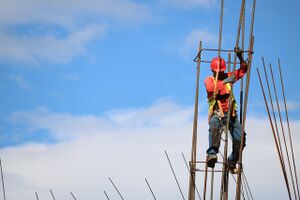Work-Related Musculoskeletal Disorders: Difference between revisions
No edit summary |
No edit summary |
||
| Line 5: | Line 5: | ||
</div> | </div> | ||
== Introduction == | == Introduction == | ||
[[File:Builder.jpeg|thumb|Builders: at risk of WRMSD ]] | |||
"Work-Related Musculoskeletal DisorderS (WRMSDs) include sprains, strains, tears, edema, fractures, compression, malalignment, disc herniation, and excessive, repetitive movements that provocate the musculoskeletal, connective, or neural tissue reactions (e.g., carpal tunnel syndrome) as a result of stressful lifting, bending, climbing, crawling, reaching, twisting, pushing, pulling, poor postural alignment, psychological stress, overexertion, or repetition." <ref name=":0">Magee DJ, Zachazewski JE, Quillen WS, Manske RC. Pathology and intervention in musculoskeletal rehabilitation. Elsevier Health Sciences; 2015 Nov 20. Available: https://www.sciencedirect.com/topics/medicine-and-dentistry/work-related-musculoskeletal-disorder<nowiki/>(accessed 24.10.2022)</ref>Nancy et al 2016 | "Work-Related Musculoskeletal DisorderS (WRMSDs) include sprains, strains, tears, edema, fractures, compression, malalignment, disc herniation, and excessive, repetitive movements that provocate the musculoskeletal, connective, or neural tissue reactions (e.g., carpal tunnel syndrome) as a result of stressful lifting, bending, climbing, crawling, reaching, twisting, pushing, pulling, poor postural alignment, psychological stress, overexertion, or repetition." <ref name=":0">Magee DJ, Zachazewski JE, Quillen WS, Manske RC. Pathology and intervention in musculoskeletal rehabilitation. Elsevier Health Sciences; 2015 Nov 20. Available: https://www.sciencedirect.com/topics/medicine-and-dentistry/work-related-musculoskeletal-disorder<nowiki/>(accessed 24.10.2022)</ref>Nancy et al 2016 | ||
Revision as of 02:44, 24 October 2022
Original Editor - Habibu salisu Badamasi
Top Contributors - Lucinda hampton, Kim Jackson and Habibu Salisu Badamasi
Introduction[edit | edit source]
"Work-Related Musculoskeletal DisorderS (WRMSDs) include sprains, strains, tears, edema, fractures, compression, malalignment, disc herniation, and excessive, repetitive movements that provocate the musculoskeletal, connective, or neural tissue reactions (e.g., carpal tunnel syndrome) as a result of stressful lifting, bending, climbing, crawling, reaching, twisting, pushing, pulling, poor postural alignment, psychological stress, overexertion, or repetition." [1]Nancy et al 2016
WRMSDs, (also known as work-related repetitive stress (overuse) injuries), historically account for a notable proportion of work injuries and workers’ compensation claims in Western industrialised countries since the late 1980s. The eidence is still conflicting regarding the extent to which work is a causal factor in the development of such disorders. However, new epidemiological studies have improved methods of differentiating between the contributions of workplace and non-workplace risk factors in the development and severity of WRMSDs.[1]
For further information see
Category:Occupational Health[edit | edit source]
Work-Related Musculoskeletal Injuries and Prevention[edit | edit source]
References[edit | edit source]
- ↑ 1.0 1.1 Magee DJ, Zachazewski JE, Quillen WS, Manske RC. Pathology and intervention in musculoskeletal rehabilitation. Elsevier Health Sciences; 2015 Nov 20. Available: https://www.sciencedirect.com/topics/medicine-and-dentistry/work-related-musculoskeletal-disorder(accessed 24.10.2022)







